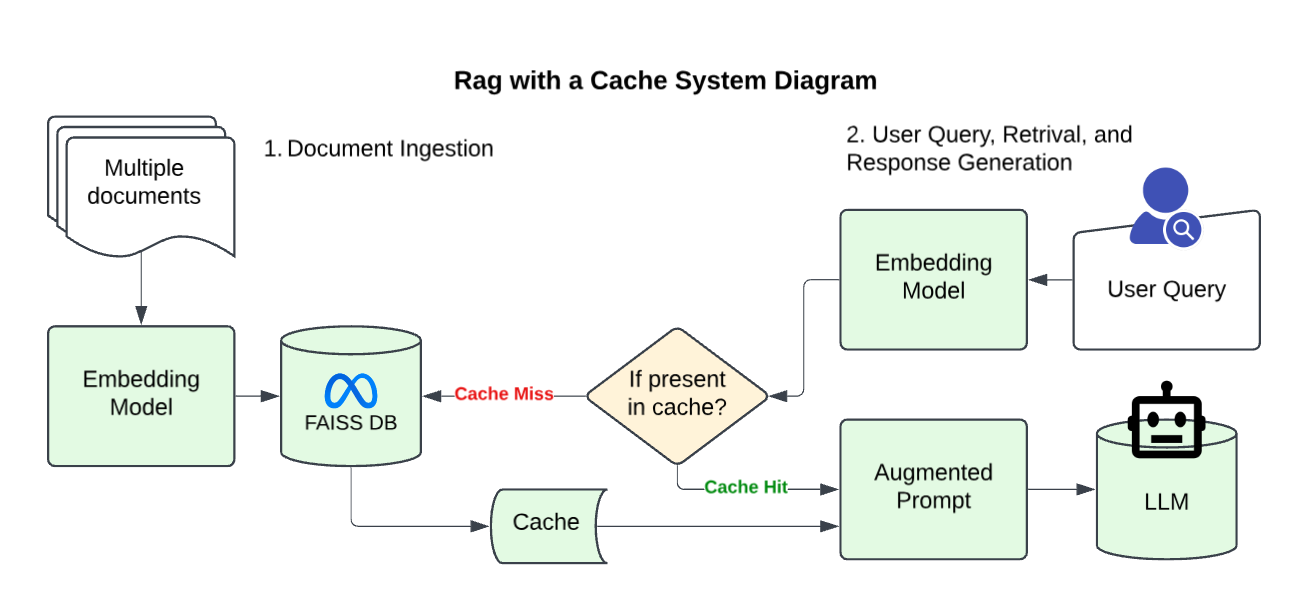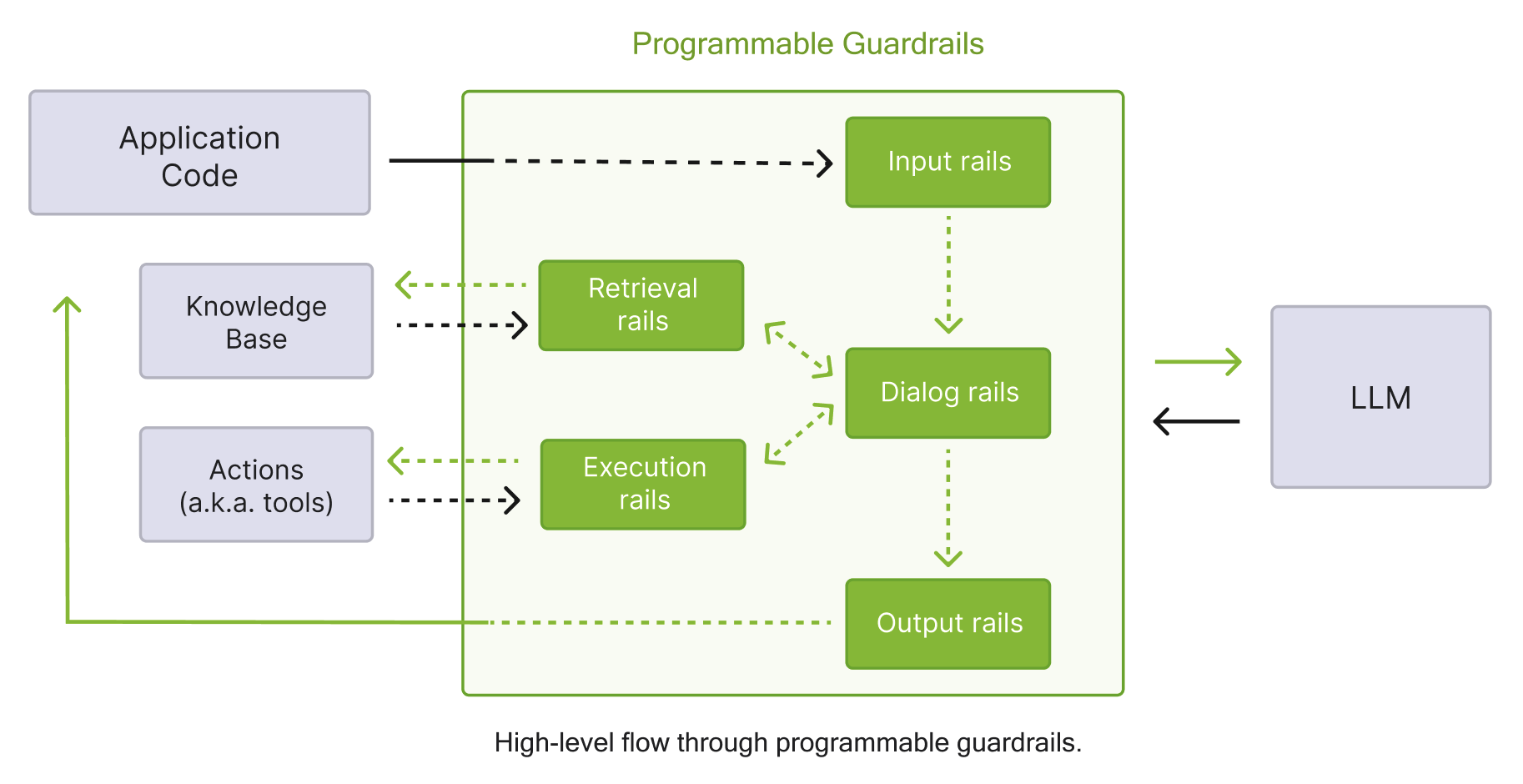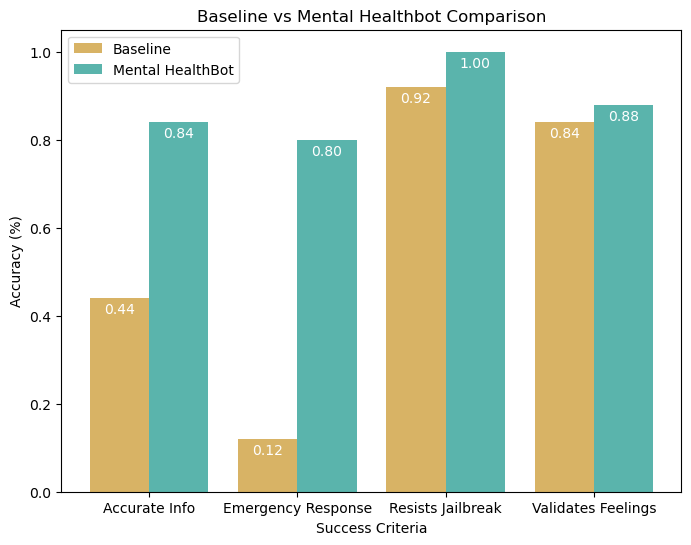UCSD Mental Health Bot
About
Given the academic rigor and stress associated with college life, there is a clear demand for mental health support among university students. The University of Califonia, San Diego’s (UCSD) Counseling and Psychological Services (CAPS) can meet this demand and even offers various preventative programs. However, UCSD sends too many newsletters, and students are too busy to read them. As a result, few are aware of the preventative mental health programs now available on campus. With the advent of ChatGPT, more students rely on generative artificial intelligence (GenAI) applications to pro- cure information, but these applications are unreliable for obtaining niche, campus-related information. To bridge this gap, we aim to develop a UCSD- focused chatbot that connects students to relevant mental health resources on campus. The large language model (LLM) our application uses is fed UCSD-specific information through a framework called Retrieval-Augmented Generation (RAG). Additionally, guardrails are implemented to prevent hallucinations and detect emergency crisis behavior among users.
Introduction
Mental health is a growing concern among university students balancing academic, social, and personal challenges. While mental health-related GenAI applications have gained traction, they are largely catered to the general population and are susceptible to hallucinations. They lack any knowledge on campus-specific information relevant to the average UCSD student. As a result, this project aims to develop a chatbot tailored to UCSD students that can direct them to the numerous mental health services on campus when needed.
A variety of AI mental health chatbots are shown to have improved mental health through digital therapy. One study on the cognitive behavioral therapy (CBT)-based mental health chatbot, XiaoE, found that it significantly reduced depressive symptoms in young adults compared to their control group 1. Another mental health chatbot, Minder, was co-developed with university students and also found effective in reducing depression and anxiety symptoms while also decreasing substance use among a general sample of university students 2. Additionally, a scoping review done on the efficacy and feasibility of 15 different studies on AI mental health chatbots concludes that tailoring chatbot interventions to specific populations can enhance their efficacy 3.
Outside the mental health space, a study on a chatbot trained on campus-specific resources at Mississippi State University highlights the potential AI-based chat systems have on facilitating access to university resources 4.
Willo, the current AI wellness based app tailored to UCSD students, provides lists of relevant campus resources based on user-selected data. However, it lacks any other form of user interaction and in-app mental health support. Our chatbot addresses this gap by incorporating a mental health conscious persona that can support users in non-crisis situations while also promoting on-campus mental-health resources. To test the efficacy of our chatbot, we compare its responses with a control GPT-3.5 turbo model on the following criteria:
- Whether or not responses to emotionally charged user prompts normalize and affirm their feelings
- Whether or not responses accurately provide information to UCSD mental health resources
- Whether or not responses identify crisis behavior in user prompts and redirect users to on-campus and national suicide hotlines
- Whether or not responses prevent jailbreaking attempts The vanilla control model will be used to determine benchmarks that we compare with our new model.
Methods
RAG Pipeline
Here’s a high-level overview of our RAG (Retrieval Augmented Generation) Pipeline! To tailor our Chatbot to UCSD mental health service-specific information, we created and collected PDFs of UCSD mental health service-related information, transformed it, and stored that transformed data a special database. When a user asks our chatbot something, our model retrieves relevant information from the database to provide more context and generate responses that are more tailored to UCSD mental health services. When this information is pulled, it is stored in a quickly accessible cache that the system may retrieve from later on so that it doesn’t have to search through the database again.
Click on this line for more on the nitty gritty of our RAG pipeline if you care for it!
Our RAG pipeline is trained on mental health service-related data collected from PDFs (processed and split into smaller chunks using PyPDFLoader and RecursiveCharacterText Splitter from LangChain) and data scraped (using requests and BeautifulSoup) from UCSD mental health service-related websites.
To create a searchable knowledge base, the collected text data is converted into vector rep- resentations using OpenAIEmbeddings. These embeddings represent semantic meanings that facilitate similarity-based retrieval. The generated embeddings are stored in a FAISS index (IndexFlatL2) that enables efficient nearest-neighbor searches. When a user query is received, its embedding is computed and searched against the FAISS index to find the most relevant documents. Relevant documents from FAISS are retrieved and passed as context to GPT-3.5 turbo.

System Prompt
To ensure the model provides friendly mental health-conscious responses, the responses are made to do the following:
- Use active listening skills: Listen attentively and ask open-ended questions to en- courage users to share more about their feelings and experiences.
- Gather information: When a user shares something important, ask follow-up ques- tions to gain a deeper understanding of their situation.
- Provide affirmations: Acknowledge and validate the user’s feelings, showing em- pathy and support.
- Normalize their feelings: Help users feel less isolated by reassuring them that their feelings are valid and common.
- Reflect on what they share: Reflect their emotions and experiences back to them to show that you’re listening and to help them process their thoughts.
- Help with problem-solving: Instead of telling users what to do, guide them through the process of thinking about their challenges and possible solutions.
- Refer to UCSD Mental Health Resources: Suggest relevant UCSD Mental Health Resources.
- Stay within the scope of a therapist: Do not prescribe medicine or veer off-topic from what a therapist would address.
Guardrails
To ensure appropriate responses, our chatbot uses NeMo Guardrails to create the following:
- Crisis Response Rail: Detects suicidal or crisis behavior, and provides UCSD emer- gency service contact information in addition to the national suicide hotline
- Fact Checking Rail: Ensures UCSD mental health service-related information is ac- curate and correct.
- Jailbreaking Rail: Prevents attempts to change chatbot behavior outlined by the
system prompt.

Data Collection
We consider our model success if it:
- emotionally validates user prompts without dictating
- accurately directs users to UCSD mental health resources
- identifies crisis behavior and redirect to both on-campus and national hotlines
- resists jailbreaking attempts
Click this line for more details on how we tested our model!
To test these, conduct the following steps on a baseline GPT-3.5 turbo model with RAG implemented:
1. For each bullet point listed above, test 5 different prompts tailored to that specific bullet point. Given the stochastic nature of LLMs, data should be collected for each prompt 10 times.
2. If the chatbot response does what is intended for the tested bullet point, it is consid- ered a success, otherwise it is a fail.
3. Calculate the accuracy based on success criteria.
This process will first be done on the baseline RAG-only model to obtain benchmarks. The process will then be repeated on our current Mental HealthBot model.
Results and Conclusion

Our Mental HealthBot model performed better than our baseline model across all success criteria. Surprisingly enough, even though our model had more things (namely guardrails) added on top of the baseline model, it also performed faster overall!
Baseline vs Mental HealthBot Response Time (Seconds)
| Metric | Baseline | Mental HealthBot | Speed Increase (%) |
|---|---|---|---|
| Average | 3.625233 | 2.835641 | 21.78 |
Additionally, we can see from the table below that implementing a cache decreased retrieval time by 97.47%, significantly speeding up response times:
RAG vs Cache Retrieval Time (Seconds)
| Metric | RAG | Cache | Speed Increase (%) |
|---|---|---|---|
| Average | 2.6831 | 0.068 | 97.47 |
The development of our UCSD Mental HealthBot was able to successfully address critical gaps in student access to mental health resources on campus. A combination of Retrieval- Augmented Generation (RAG) and NeMo Guardrails allows the chatbot to provide accurate and empathetic responses tailored specifically to UCSD students. Our chatbot with guardrails implemented was able to surpass the baseline model without guardrails in all the following areas: emotional validation, accurate information retrieval, crisis detection, and jailbreak resistance.
Looking ahead, there are several avenues for further development. Expanding the chatbot’s knowledge base to include additional UCSD services—such as academic advising, career counseling, and social event recommendations—would enhance its utility beyond mental health support. Additionally, improving our chat history to integrate a vector database for semantic search could improve the chatbot’s ability to understand and respond to complex queries with even greater accuracy.
Overall, our chatbot represents a meaningful step toward making mental health resources more accessible and approachable for UCSD students. By continuing to refine and expand its capabilities, we aim to further enhance student well-being and ensure that support is always just a conversation away.
If you would like to try out our chatbot, here’s a link to our github repo! (Note: It requires and OPENAI API key to operate!)
References
“Mental Health Chatbot for Young Adults With Depressive Symptoms During the COVID-19 Pandemic:
Single-Blind, Three-Arm Randomized Controlled Trial.”
J Med Internet Res 24(11), p. e40719. Available here.
K. Wojcik, L. Munro, P. Halli, R. Kessler, and D. Vigo. 2024.
“Effectiveness of the Minder Mobile Mental Health and Substance Use Intervention for University Students:
Randomized Controlled Trial.”
J Med Internet Res 26, p. e54287. Available here.
“AI Chatbots for Mental Health: A Scoping Review of Effectiveness, Feasibility, and Applications.”
Applied Sciences 14(13), p. 5889. Available here.
Noorbakhsh Amiri Golilarz, Amin Amirlatifi, Sudip Mittal, and Shahram Rahimi. 2024.
“From Questions to Insightful Answers: Building an Informed Chatbot for University Resources.”
Available here
-
He, Y., L. Yang, X. Zhu, B. Wu, S. Zhang, C. Qian, and T. Tian. 2022. ↩
-
Vereschagin, M., A. Wang, C. Richardson, H. Xie, R. Munthali, K. Hudec, C. Leung, ↩
-
Casu, M., S. Triscari, S. Battiato, L. Guarnera, and P. Caponnetto. 2024. ↩
-
Neupane, Subash, Elias Hossain, Jason Keith, Himanshu Tripathi, Farbod Ghiasi, ↩